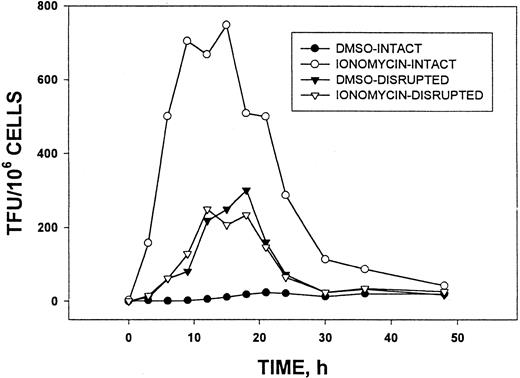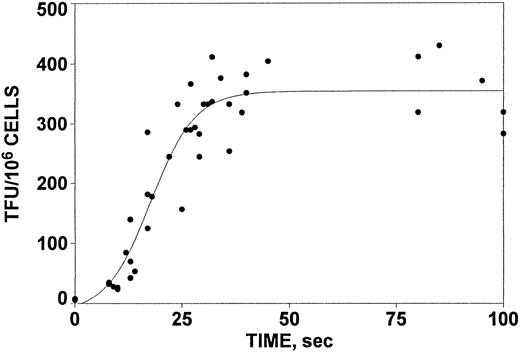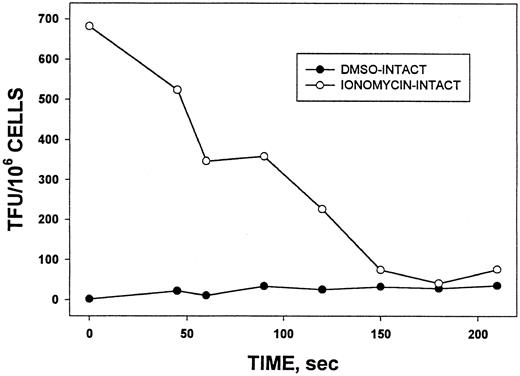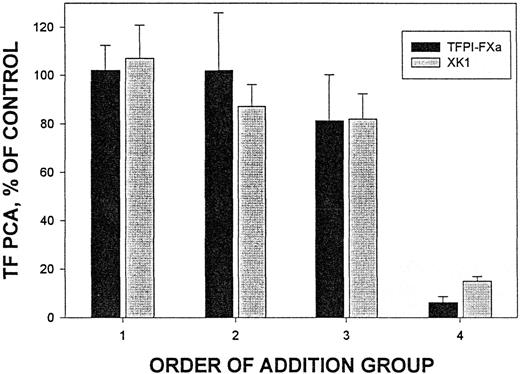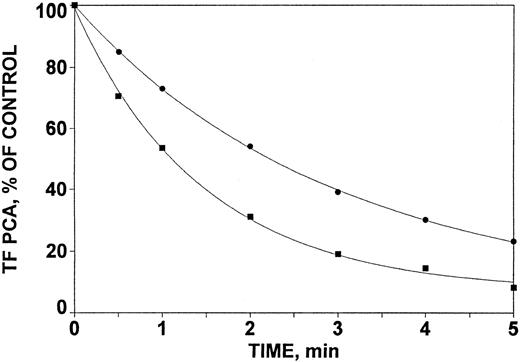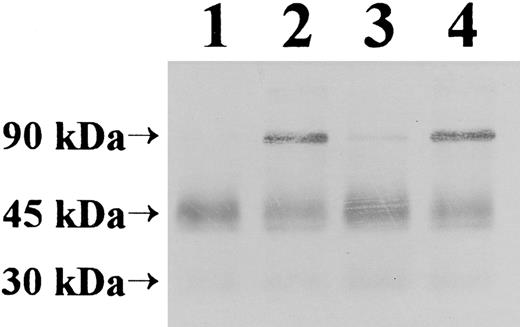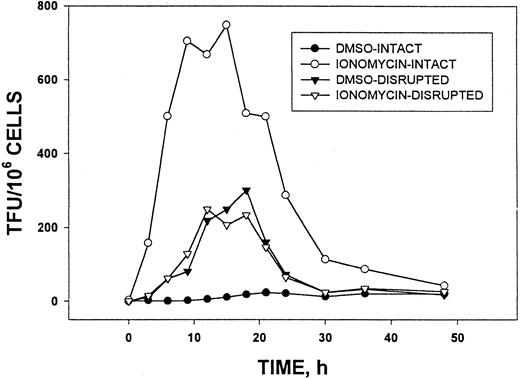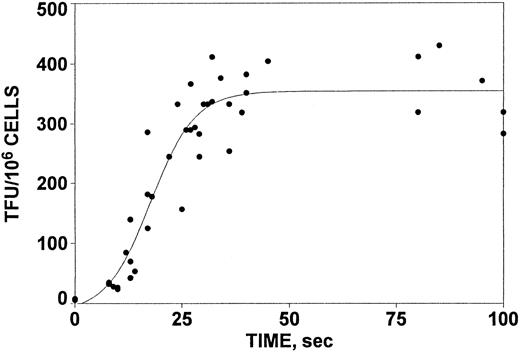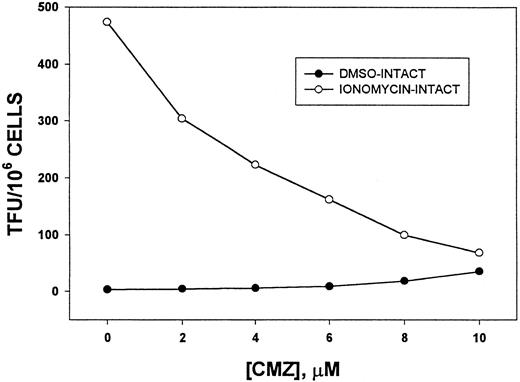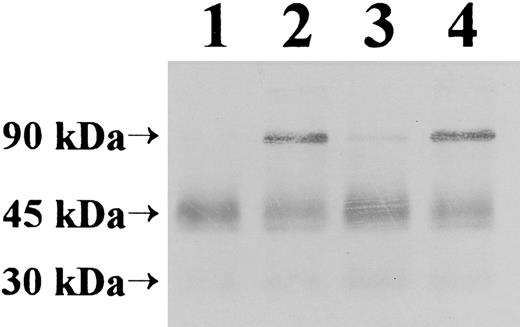Abstract
Tissue factor (TF ) procoagulant activity (PCA) on the surface of intact HL-60 cells is encrypted. This latent TF PCA was activated by exposing the cells to ionomycin, a calcium ionophore. Within seconds an increase in TF PCA of greater than 100-fold was observed. The ionomycin effect was blocked by pretreating the cells with calmidazolium, a calmodulin inhibitor. Changes in TF structure and function, coincident with the ionophore-induced increase in TF PCA, were identified. TF-factor VIIa complexes formed on both untreated and ionophore-treated cells, but pseudosubstrate inhibitors only bound to TF-factor VIIa on the ionophore-treated cells. TF PCA was inhibited by reacting cells with sulfosuccinimidyl-6-(biotinamido)hexanoate, and the rate of this reaction increased twofold after cells were exposed to ionomycin. When proteins on the surface of untreated cells, expressing minimal TF PCA, were cross-linked with 3-3′-dithiobis(sulfosuccinimidylpropionate), cross-linked TF dimers were produced. TF cross-linking was prevented by first treating the cells with ionomycin. These results suggest a mechanism for the ionomycin-induced increase in TF PCA. TF activation appears to be a calmodulin-dependent process, which exposes an essential macromolecular substrate binding site on TF, possibly as the result of a change in TF quaternary structure.
TISSUE FACTOR (TF ) is the primary initiator of blood coagulation. TF procoagulant activity (PCA) is essential for normal hemostasis and faulty expression of TF PCA is believed to be a trigger for thrombosis. Despite the central role of TF in blood coagulation, the mechanisms underlying the regulation of TF PCA in vivo are not fully known.
Studies with cultured cells have clearly shown that unperturbed cells, even if they contain TF, are weak procoagulants. The cells must be disrupted or exposed to a calcium ionophore for the latent TF PCA to be fully expressed.1-4 This observation suggests that there is posttranslational control of TF PCA. Although the mechanism of this encryption of TF PCA on cells has not been characterized, several relevant observations have emerged. TF is the only coagulation protein that is neither activated nor inactivated by proteolysis.1 Also, despite its inability to promote coagulation, TF is available on unperturbed cells to bind either factor VII (FVII) or activated factor VII (FVIIa).5-7 Thus, restricted formation of TF-FVII and TF-FVIIa complexes is not the physical basis for the encryption of TF PCA. Phosphatidylserine (PS) has been proposed as a regulator of TF PCA on cell-surfaces. This hypothesis is based on the evidence that addition of PS to reconstituted phospholipid vesicles containing TF enhances TF PCA,2,8 and PS is normally sequestered on the inner leaflet of the plasma membrane.9 However, the biological significance of PS as a modulator of TF-initiated coagulation requires experimental verification.
This study investigates the regulated expression of TF PCA on intact HL-60 cells. Ionomycin, a calcium ionophore, is the agent employed to activate the latent TF PCA. Changes in TF structure and function are identified which coincide with the ionophore-induced activation of TF PCA. The results suggest that the appearance of a macromolecular substrate binding site on TF is the event which defines TF activation. Changes in TF structure that may account for this change in TF function are discussed. Also, the hypothetical role of PS asymmetry in the regulation of TF PCA on cells is reexamined.
MATERIALS AND METHODS
Materials.HL-60 cells were ordered from the American Type Culture Collection (Rockville, MD). Tissue culture materials and prestained proteins standards were from GIBCO-BRL (Grand Island, NY). Reagents for sodium dodecyl sulfate-polyacrylamide gel electrophoresis (SDS-PAGE) and Western blotting were purchased from BioRad (Hercules, CA). Normal citrated human plasma was from Pacific Hemostasis (Huntersville, NC). Ionomycin, calmidzaolium (CMZ), phorbol myristate acetate (PMA), and Triton X-100 were purchased from Calbiochem (San Diego, CA). Activated factor X (FXa), bovine serum albumin (BSA), phosphate-buffered saline (PBS), and rabbit brain cephalin were from Sigma (St Louis, MO). Sulfosuccinimidyl-6-(biotinamido)hexanoate (sulfo-NHS-biotin) was the product of Vector Labs Inc (Burlingame, CA). The cross-linking reagent 3-3′-dithiobis(sulfosuccinimidylpropionate) (DTSSP) was purchased from Pierce (Rockford, IL). Tissue factor pathway inhibitor (TFPI) and XK1 were gifts of Dr George J. Broze, Jr (Washington University School of Medicine, St Louis, MO). All other materials were reagent grade or better.
Cell culture.HL-60 cells were grown in a medium composed of Iscove's modified Dulbecco's medium, 20% fetal calf serum, and 0.5% gentamicin. The day before an experiment, cells were pelleted and resuspended in fresh medium at 106 cells per mL. The day of an experiment, 1 μmol/L PMA was added to the cells from a 1 mmol/L stock solution dissolved in dimethyl sulfoxide (DMSO). After 6 hours, the cells were procured by centrifugation and washed twice with HEPES buffered saline (HBS). The HBS was composed of 137 mmol/L NaCl, 5.38 mmol/L KCl, 5.55 mmol/L glucose, and 10 mmol/L HEPES at pH 7.5. The washed cells were resuspended in either HBS or HBS with 0.1% BSA (HBSA) containing 12.5 mmol/L CaCl2 . The cells were counted in a hemocytometer and diluted to 106 per mL. Viability was estimated by Trypan blue exclusion.
Assay for TF PCA.The TF PCA of intact HL-60 cells was quantified with a prothrombin time (PT) assay. PT assays were performed in a Coag-a-mate XM coagulation instrument (Organon Technika, Durham, NC) at 37°C. HL-60 cells were suspended in HBS or HBSA containing 12.5 mmol/L CaCl2 at 106 cells per mL, and 200 μL of each sample were transferred in duplicate to the coagulation instrument cuvette. The temperature was equilibrated for 3 minutes and the PT assay was initiated by the addition of 100 μL plasma. The plasma was prepared by mixing 9 volumes of reconstituted normal citrated human plasma and 1 volume of reconstituted rabbit brain cephalin, followed by a 3 minute incubation at 37°C. When the activity of disrupted cells was determined, the cells were frozen and thawed five times before the PT assay. The PT assay was calibrated with human brain TF reconstituted into phospholipid vesicles containing 70% phosphatidylcholine and 30% PS, as described elsewhere.8 This PT assay standard was arbitrarily designated as containing 1 U of TF PCA (TFU) per 1 pg TF protein. The specificity of the PT assay for TF was established by showing that the ability of the PMA-stimulated HL-60 cells to shorten the clotting time was inhibited by > 99% with murine monoclonal and rabbit polyclonal IgG against pure human TF (data not shown).
TFPI-FXa and XK1 order of addition experiments.TFPI-FXa was prepared by combining 5 μmol/L TFPI and 5 μmol/L FXa in HBS overnight at 4°C. The TFPI-FXa was stored at −80°C. In the order of addition experiments, four tubes containing HL-60 cells at 106 cells per mL in HBS with 12.5 mmol/L CaCl2 were prepared as described above. FVIIa (1 nmol/L) was added and after 10 minutes at 37°C two samples received 10 μmol/L ionomycin and two received vehicle (0.1% DMSO). After 5 minutes one ionophore-treated sample and one untreated sample received the pseudosubstrate inhibitor. TFPI-FXa was diluted from a 1 μmol/L stock in HBS to a final concentration of 1 nmol/L, and XK1 was diluted from a 1 μmol/L stock in HBS to a final concentration of 5 nmol/L. The other samples received buffer. After 5 minutes the cells were pelleted at 10,000 RPM in an Eppendorf 5415C microfuge at room temperature for 30 seconds and washed twice with HBSA containing 12.5 mmol/L CaCl2 to remove unbound FVIIa and inhibitor. The washed cell pellets were resuspended in the buffer and counted. Finally, all cell samples were stimulated with 10 μmol/L ionomycin for 3 minutes and assayed for TF PCA.
Sulfo-NHS-biotin inhibition.PMA-stimulated HL-60 cells were prepared by the protocol described previously. Washed cells were resuspended in HBS containing 12.5 mmol/L CaCl2 at a final concentration of 106 cells per mL and warmed to 37°C. The cells then received either 10 μmol/L ionomycin or vehicle (0.1% DMSO). After 3 minutes, sulfo-NHS-biotin was added to a final concentration of 2 mmol/L from a 50 mmol/L stock solution in HBS. At each time point the reaction was terminated by the addition of an equal volume of HBSA containing 12.5 mmol/L CaCl2 and 20 mmol/L glycine. The cells were pelleted in a microfuge as described above. The supernatants were discarded and the cell pellets were resuspended in HBSA containing 12.5 mmol/L CaCl2 at the original volume. After incubation at 37°C for 1 minute, 10 μmol/L ionomycin was added each sample. TF PCA was measured in the PT assay by the established protocol 3 minutes after the ionophore treatment.
DTSSP cross-linking.The HL-60 cells were stimulated with PMA and washed as described. The washed cells were resuspended at 4 × 106 cells per mL in HBS containing 12.5 mmol/L CaCl2 and warmed to 37°C. Either 10 μmol/L CMZ or vehicle (0.1% DMSO) was added, and after incubating for 5 minutes the cells received either 10 μmol/L ionomycin or vehicle (0.1% DMSO). After 5 minutes the cells were pelleted as described above and resuspended in ice-cold PBS at 107 cells per mL. DTSSP was added at final concentration of 10 mmol/L. A control sample received no DTSSP. The cross-linking reaction was conducted on ice for 60 minutes and was terminated by the addition of 1/10 volume 1 mol/L glycine pH 7.5 and 1/10 volume 1 mol/L Tris pH 7.5. After 15 minutes at room temperature, Triton X-100 was added to a final concentration of 1% and the samples were mixed for 30 minutes at room temperature to extract the TF. Cell debris was removed by a brief centrifugation. TF was immunopurified from the detergent extracts as described previously.10 Before SDS-PAGE, Triton X-100 was removed by ethanol extraction.
SDS-PAGE and Western blotting.SDS-PAGE was performed on 10% acrylamide gels by the method of Laemmli.11 The proteins were electroeluted onto nitrocellulose in 192 mmol/L glycine, 25 mmol/L Trizma base, and 20% methanol. The nitrocellulose was blocked with 1% BSA in Tris buffered saline (TBS) composed of 100 mmol/L NaCl and 50 mmol/L Tris pH 7.5. The blot was incubated for 4 hours with rabbit polyclonal IgG raised against pure human brain TF (1 μg/mL in TBS with 1% BSA and 0.1% Tween 20). Next, the blot was then washed extensively in TBS containing 0.1% Tween 20 and incubated with goat antirabbit IgG conjugated to alkaline phosphatase in TBS with 1% BSA and 0.1% Tween 20 for 2 hours. After a second wash the blot was developed. The color development solution containing 5-bromo-4-chloro-3-indolyl phosphate and p-nitroblue tetrazolium chloride was prepared according to the manufacturer's instructions. Densitometry was performed with a UMAX optical scanner (UMAX Technologies, Fremont, CA) and NIH Image 1.54 software (Bethesda, MD). The 30-kD nascent TF polypeptide band was employed as the internal standard to correct the data for variations in sample yield.
RESULTS
To define the optimum experimental conditions and illustrate the cryptic nature of TF PCA on HL-60 cells, the time course of PMA-stimulated TF generation was determined. The results of this experiment are presented in Fig 1. Cells were exposed to 10−6 mol/L PMA for the times indicated. The intact cells were assayed for TF PCA either untreated or following a brief exposure to 10 μmol/L ionomycin, as described in Materials and Methods. Maximum TF PCA was observed 6 to 12 hours following the addition of PMA. The dramatic increase in the expression of TF PCA on intact cells following the ionophore treatment is the most striking feature of this experiment. It underscores the fact that TF on the surface of an unperturbed cell is in a quiescent state, and calcium influx into the cell activates this latent TF PCA. At the peak, the TF PCA of the intact ionomycin-treated cells was 120- to 550-fold greater than that of intact cells, which received no ionophore.
Time course of PMA-stimulated TF synthesis in HL-60 cells. TF gene expression was induced in HL-60 cells with 1 μmol/L PMA. The X-axis is the time after the addition of PMA. At each time point the intact cells were assayed for TF PCA after the addition of 10 μmol/L ionomycin or 0.1% DMSO. The cell samples were then disrupted by freezing and thawing (5×) and reassayed.
Time course of PMA-stimulated TF synthesis in HL-60 cells. TF gene expression was induced in HL-60 cells with 1 μmol/L PMA. The X-axis is the time after the addition of PMA. At each time point the intact cells were assayed for TF PCA after the addition of 10 μmol/L ionomycin or 0.1% DMSO. The cell samples were then disrupted by freezing and thawing (5×) and reassayed.
Next, the intact cells were disrupted and reassayed. Following disruption the TF PCAs of the untreated and the ionophore-treated cells were the same at each time point. At the peak, 6 to 12 hours after the addition of PMA, the TF PCA of the disrupted cells was 40- to 70-fold greater than the activity of the intact untreated cells. However, the TF PCA of the disrupted cells was threefold to ninefold less than the activity of the intact ionophore-treated cells. Thus, in the PT assay with HL-60 cells as the TF source, ionomycin was a more potent enhancer of TF PCA than cell disruption. The doses of PMA and ionomycin employed in this experiment were previously determined to be optimal. The identity of the procoagulant was confirmed by inhibition with TF-specific inhibitory antibodies (data not shown).
The effect of ionomycin on the expression of cell-surface TF PCA was investigated further by measuring TF PCA as a function of time after the addition of ionomycin. The results of this experiment are presented in Fig 2. The X-axis is the time from the addition of 10 μmol/L ionomycin to the initiation of the PT assay. The effect of the ionophore on the expression of cell-surface TF PCA was rapid. Complete TF activation was achieved in less than 1 minute. It must be noted that the PT assay is not an instantaneous measure of TF PCA. Therefore, the rate appearance of TF PCA as determined by this procedure is only an approximation. This result shows that the signal transduction pathway going from calcium influx to TF activation uses a set of preexisting cytosolic and/or membrane components, ie, de novo protein synthesis is not required.
Time course of the ionomycin-induced increase in TF PCA. The X-axis is the time from the addition of 10 μmol/L ionomycin to the initiation of the PT assay. The TF PCA of the intact ionophore-stimulated HL-60 cells was measured as described in Materials and Methods.
Time course of the ionomycin-induced increase in TF PCA. The X-axis is the time from the addition of 10 μmol/L ionomycin to the initiation of the PT assay. The TF PCA of the intact ionophore-stimulated HL-60 cells was measured as described in Materials and Methods.
Previous work suggested a role for calmodulin (CaM) in the calcium ionophore-induced increase in TF PCA on cells.2 Therefore, the effect of CMZ, a potent inhibitor of CaM, was tested. First, the PMA-stimulated HL-60 cells were treated with CMZ. Then, the cells were exposed to either 10 μmol/L ionomycin or vehicle and assayed for TF PCA. The results are presented in Fig 3. CMZ produced a dose-dependent decrease in the ionomycin-induced expression of TF PCA on intact HL-60 cells. Nearly complete inhibition was achieved with 10 μmol/L CMZ. This result suggests that TF activation, triggered by calcium influx into the cytosol, is a CaM-related process.
CMZ inhibition of the ionomycin-induced increase in TF PCA (dose response). CMZ was added to the HL-60 cells at the concentrations indicated on the X-axis. After 5 minutes the cells were treated with 10 μmol/L ionomycin or 0.1% DMSO. The PT assays were performed with the intact cells 3 minutes later.
CMZ inhibition of the ionomycin-induced increase in TF PCA (dose response). CMZ was added to the HL-60 cells at the concentrations indicated on the X-axis. After 5 minutes the cells were treated with 10 μmol/L ionomycin or 0.1% DMSO. The PT assays were performed with the intact cells 3 minutes later.
The time course of CMZ inhibition was determined by adding 10 μmol/L CMZ to the cells at various times before the administration of 10 μmol/L ionomycin. The results of this experiment are shown in Fig 4. The X-axis represents the time in seconds from the addition of CMZ to the addition of ionomycin or DMSO. CMZ had no effect on the TF PCA of the untreated cells. However, a time dependence was observed for CMZ inhibition of the ionomycin-induced TF PCA. For complete inhibition the cells had to receive CMZ at least 2.5 minutes before the ionophore. Shorter exposures resulted in less inhibition. Once the TF PCA was fully activated by the ionophore treatment, CMZ had no effect. The time dependence of CMZ inhibition along with controls, which determined that 10 μmol/L CMZ did not decrease cell viability and did not inhibit the PT assay (data not shown) support the conjecture that CMZ blocks TF activation by inhibiting CaM. Additional support for the participation of CaM in TF activation comes from previous work in which trifluorperizine, a CaM inhibitor structurally unrelated to CMZ, inhibited the calcium ionophore A23187-induced increase of TF PCA on intact bovine cells.2
CMZ inhibition of the ionomycin-induced increase in TF PCA (time course). The X-axis is the time from the addition of 10 μmol/L CMZ to the addition of 10 μmol/L ionomycin. The intact HL-60 cells were assayed for TF PCA 3 minutes after the ionophore treatment.
CMZ inhibition of the ionomycin-induced increase in TF PCA (time course). The X-axis is the time from the addition of 10 μmol/L CMZ to the addition of 10 μmol/L ionomycin. The intact HL-60 cells were assayed for TF PCA 3 minutes after the ionophore treatment.
The next step in the investigation of TF activation was to examine specific aspects of TF function before and after exposure of the cells to ionomycin. An order of addition experiment was designed to answer two questions. First, does FVIIa bind to TF before and after the addition of ionophore? Second, do pseudosubstrate inhibitors, TFPI-FXa12 and the related chimeric construct XK1,13 bind to TF-FVIIa on both untreated and ionophore-treated cells? Previous studies with other cells have shown that FVIIa binds to TF on untreated cells.5-7 However, it was deemed essential to establish this fact for HL-60 cells under the conditions employed in these experiments. It was anticipated that the pseudosubstrates would discriminate between the latent TF-FVIIa present on untreated cells and the procoagulant TF-FVIIa on ionophore-treated cells. The order of addition experiments were performed as described in Materials and Methods. In each experiment four samples were prepared and assayed: 1. (FVIIa → DMSO → buffer → wash → ionomycin), 2. (FVIIa → ionomycin → buffer → wash → ionomycin), 3. (FVIIa → DMSO → pseudosubstrate → wash → ionomycin), 4. (FVIIa → ionomycin → pseudosubstrate → wash → ionomycin). The control for this experiment, which by definition expressed 100% TF PCA, was a cell sample incubated with FVIIa, stimulated with ionomycin, and assayed without additional manipulations.
The results of the TFPI-FXa experiment are presented in Fig 5 (black bars). The first two samples were pretreated with FVIIa and either vehicle or ionomycin. At the end of the procedure the TF PCAs of samples 1 and 2 were 102% ± 10% and 102% ± 24% of the control activity. Thus, it appears that TF-FVIIa complexes formed on both untreated and ionomycin-treated cells. Samples 3 and 4 were the same as 1 and 2 except that they were exposed to TFPI-FXa. The TF PCA of the DMSO-treated sample 3 was 81% ± 19% of the control. The TF PCA of the ionophore-treated sample 4 was 6.2% ± 2.4% of the control. From these results it appears that TF-FVIIa-TFPI-FXa complexes readily formed on ionophore-treated cells, but TF-FVIIa on untreated cells was resistant to TFPI-FXa inhibition. This experiment was repeated with 10 nmol/L TFPI-FXa with essentially identical results (data not shown).
Pseudosubstrate inhibition of TF-FVIIa on HL-60 cells before and after ionomycin stimulation. The details of these order of addition experiments are presented in Materials and Methods. The data were corrected for cell loss and normalized against a control sample (100% TF PCA) as described. The black bars are the data from the experiment employing TFPI-FXa (N = 3). The gray bars are the data from the XK1 experiment (N = 3). The standard deviations are represented by the error bars. The order of addition groups were as follows: (1) FVIIa → DMSO → buffer → wash → ionomycin (2) FVIIa → ionomycin → buffer → wash → ionomycin (3) FVIIa → DMSO → TFPI-FXa (A) or XK1 (B) → wash → ionomycin (4) FVIIa → ionomycin → TFPI-FXa (A) or XK1 (B) → wash → ionomycin.
Pseudosubstrate inhibition of TF-FVIIa on HL-60 cells before and after ionomycin stimulation. The details of these order of addition experiments are presented in Materials and Methods. The data were corrected for cell loss and normalized against a control sample (100% TF PCA) as described. The black bars are the data from the experiment employing TFPI-FXa (N = 3). The gray bars are the data from the XK1 experiment (N = 3). The standard deviations are represented by the error bars. The order of addition groups were as follows: (1) FVIIa → DMSO → buffer → wash → ionomycin (2) FVIIa → ionomycin → buffer → wash → ionomycin (3) FVIIa → DMSO → TFPI-FXa (A) or XK1 (B) → wash → ionomycin (4) FVIIa → ionomycin → TFPI-FXa (A) or XK1 (B) → wash → ionomycin.
The experiment was repeated with XK1 substituted for TFPI-FXa. This recombinant chimeric form of TFPI-FXa is a single polypeptide chain composed of the light chain of FXa and the first Kunitz domain of TFPI.13 The XK1 results are presented in Fig 5 (gray bars). As in the previous experiment the TF PCAs of sample 1 and sample 2 (107% ± 14% and 87% ± 9%) were essentially the same as the control. When XK1 was added along with FVIIa, the TF PCA of the DMSO-treated cells in sample 3 (82% ± 10%) was only slightly inhibited whereas the TF PCA of the ionophore-treated cells in sample 4 (15% ± 10%) was almost totally inhibited. Thus, it appears that the formation of TF-FVIIa-XK1 complexes was facilitated by the ionophore treatment.
To correlate a change in TF structure with TF activation, the modification of essential amino groups on TF with sulfo-NHS-biotin was quantified. Previous work has shown that this amino-reactive reagent reacts preferentially with lys165 and lys166 on pure recombinant TF and this chemical modification inactivates TF.14 From mutagenesis and crystallographic studies it appears that lys165 and lys166 comprise part of the macromolecular substrate binding pocket on TF but are not involved in FVIIa binding.14-19
The TF PCA of the intact untreated and ionomycin-treated cells was determined as a function of time following the addition of 2 mmol/L sulfo-NHS-biotin. The experiment was performed as described in Materials and Methods, and the results are presented in Fig 6. The X-axis is the time from the addition of sulfo-NHS-biotin to the quenching of the reaction with excess glycine. TF PCA appeared to decrease exponentially for both the untreated and the ionophore-treated cells. The rate of inhibition of TF PCA by 2 mmol/L sulfo-NHS-biotin was 0.34⋅min−1 for the untreated cells and 0.69⋅min−1 for the ionomycin-treated cells. In other words, it appears that essential lysines, probably lys165 and lys166, were modified more rapidly following TF activation. This increase in the rate of the reaction argues for a structural change in TF, which is coincident with the ionophore-induced increase in TF PCA. A change in conformation and/or quaternary structure, which alters the chemical environment of the reactive amino groups could account for this enhanced inhibition.
Time course of sulfo-NHS-biotin inhibition of TF PCA on untreated ionomycin-treated HL-60 cells. Untreated (•) and ionomycin-treated (▪) HL-60 cells were exposed to 2 mmol/L sulfo-NHS-biotin. At the times indicated on the X-axis the reactions were terminated by the addition of excess glycine. After washing, the intact cells were stimulated with 10 μmol/L ionomycin and assayed for TF PCA. The equation y = a + bexp(−kx) was fitted to the data. Both sets of data were well described by the equation, r2 = .99.
Time course of sulfo-NHS-biotin inhibition of TF PCA on untreated ionomycin-treated HL-60 cells. Untreated (•) and ionomycin-treated (▪) HL-60 cells were exposed to 2 mmol/L sulfo-NHS-biotin. At the times indicated on the X-axis the reactions were terminated by the addition of excess glycine. After washing, the intact cells were stimulated with 10 μmol/L ionomycin and assayed for TF PCA. The equation y = a + bexp(−kx) was fitted to the data. Both sets of data were well described by the equation, r2 = .99.
The sulfo-NHS-biotin inhibited cells were disrupted and reassayed. The TF PCA of the disrupted cells was inhibited to the same degree as the intact cells (data not shown). The failure to observed a sequestered pool of uninhibited TF suggests that most of the TF was on surface of the HL-60 cells and available to react with the reagent. When the intact cells received FVIIa and either TFPI-FXa or XK1 before the inhibitor, sulfo-NHS-biotin inhibition was significantly reduced. However, this protection of TF was evident only when the cells were ionophore treated (data not shown). FVIIa, TFPI-FXa, and XK1 were not protective when added individually.
Previous work has clearly shown that TF binds to itself both in reconstituted phospholipid vesicles and on the surface of cells.6,8,20 Therefore, to correlate a possible change in TF quaternary structure with TF activation, a nearest neighbor analysis of cell-surface TF was performed. The HL-60 cells were treated with DTSSP, a homobifunctional amino-reactive protein cross-linker, which was used in a previous investigation to cross-link cell-surface TF.20 The cross-linking was performed as described in Materials and Methods. The reaction was conducted at 0°C to restrict the mobility of membrane proteins and reduce nonspecific cross-linking. Following the reaction, TF was immunopurified and visualized by Western blotting (see Fig 7). The control in lane 1 was a sample of TF immunopurified from HL-60 cells, which received no DTSSP. The mature glycosylated TF is the major band of antigen with an apparent molecular weight of 45 kD. The minor band at 30 kD is nascent TF polypeptide, which has not yet been glycosylated.1,21 22 The blot was analyzed by densitometry as described in Materials and Methods.
DTSSP cross-linking of TF on HL-60 cells. details of the DTSSP cross-linking and the Western blot analysis are presented in Material and Methods. Each lane contained the TF immunopurified from 5 × 107 cells. The immunopurified TF samples were run unreduced on a 10% acrylamide Laemmli gel in the following order: lane 1, untreated cells (no DTSSP); lane 2, untreated cells + DTSSP; lane 3, ionomycin-treated cells + DTSSP; ionomycin-treated cells (pretreated with CMZ) + DTSSP.
DTSSP cross-linking of TF on HL-60 cells. details of the DTSSP cross-linking and the Western blot analysis are presented in Material and Methods. Each lane contained the TF immunopurified from 5 × 107 cells. The immunopurified TF samples were run unreduced on a 10% acrylamide Laemmli gel in the following order: lane 1, untreated cells (no DTSSP); lane 2, untreated cells + DTSSP; lane 3, ionomycin-treated cells + DTSSP; ionomycin-treated cells (pretreated with CMZ) + DTSSP.
The TF from unperturbed HL-60 cells which were cross-linked with DTSSP is shown in lane 2. Cross-linking produced a 37% decrease in the 45 kD TF band. Thirty-one percent of the cross-linked TF was shifted to a band at 90 kD and 1% appeared in higher molecular weight bands near the top of the gel. The remaining 5% of the TF antigen could not be accounted for. This loss may be due to decreased antigenicity of the DTSSP cross-linked TF, inefficient transfer to nitrocellulose of the high molecular weight forms of TF, or a reduced yield of cross-linked TF during immunopurification. In the previous TF cross-linking study it was determined that the products of DTSSP cross-linking were TF homodimers and TF homomultimers.20 Therefore, the 90-kD band in lane 2 is probably dimeric TF, and antigenic material near the top of the gel is probably the multimeric TF.
When the cells were treated with ionomycin before cross-linking (lane 3) only a trace of cross-linked TF was observed at 90 kD. The decreased cross-linking suggests that TF does not self-associate on ionophore-treated cells. When cells were exposed to 10 μmol/L CMZ before the addition of ionomycin the products of DTSSP cross-linking (lane 4) were essentially identical those obtained with the untreated cells (line 2). Thus, in addition to inhibiting the increase in TF PCA, it appears that CMZ blocked the ionophore-induced change in TF quaternary structure.
DISCUSSION
Initially, the role of cytosolic calcium in the encryption of TF PCA on unperturbed HL-60 was investigated. From the results presented in Fig 1 it appears that a calcium influx into the cytosol triggers the activation of this latent TF PCA on intact HL-60 cells. The rapid appearance of the activity, Fig 2, clearly shows that de novo protein synthesis is not involved. Also, the inhibition by CMZ, Figs 3 and 4, strongly implicates CaM as an essential link in the process.
TF activation on HL-60 cells was defined in functional terms by the order of addition experiments summarized in Fig 5. In accord with previous work, FVIIa bound to TF on untreated cells as well as ionophore-treated cells.5-7 Thus, restricted formation of TF-FVIIa does not account for cryptic TF PCA. The pseudosubstrates TFPI-FXa and XK1 were potent inhibitors TF-FVIIa on ionomycin-treated cells but very weak inhibitors of TF-FVIIa on untreated cells. This suggests that the appearance of a macromolecular substrate binding site is the event which defines TF activation.
Changes in TF structure coincident with TF activation were identified. The increase in the rate of sulfo-NHS-biotin inhibition of TF PCA following the addition of ionomycin, Fig 6, implies that the chemical environment of essential lysines on the surface of TF is changed by the ionophore treatment. The modified lysines are probably lys165 and lys166 in the macromolecular substrate binding site.14-19 TF self-association on HL-60 cells was detected by cross-linking of cell-surface proteins with DTSSP (Fig 7). The failure to cross-link TF following exposure of the cells to ionomycin suggests that calcium influx into the cytosol produces a change in TF quaternary structure. Both the TF cross-linking and the encrypted TF PCA were preserved by treating the cells with CMZ before the addition of ionophore. This coincidence suggests that the change in TF structure and the change in TF function are linked.
Approximately 40% of the TF molecules were cross-linked by DTSSP on unperturbed HL-60 cells. This result is similar to the 50% yield of DTSSP cross-linked TF previously reported.20 The sulfo-NHS-biotin inhibition data suggest that most of the TF molecules are on the surface of the HL-60 cells and available for chemical modification. Therefore, the failure to achieve 100% cross-linking is probably due to the inefficiency of the reaction. Regardless of the yield, the cross-linking experiment does not definitively prove that a change in TF quaternary structure is responsible for a change in TF function, but it establishes a strong correlation between structure and function.
A model for the mechanism of TF activation which is consist with these data is one in which TF forms dimers on the surface of unperturbed cells. Calcium influx into the cytosol triggers a CaM-dependent process, which causes the TF dimers to dissociate. This change in quaternary structure exposes an essential macromolecular substrate binding site on monomeric TF. Thus, the inactive TF dimers are converted to procoagulant TF monomers. The cryptic dimer model of TF activation runs counter to a well-established dogma. Self-association usually results in the activation of cell-surface receptors. Human growth hormone receptor, a member of the same receptor superfamily as TF, is an example of this paradigm.17 23 There are other models of TF encryption which are consistent with the data. For example, TF may be encrypted by the binding of an inhibitor which is not another TF molecule. Alternatively, the TF monomer may regulate substrate binding and the expression of TF PCA by a conformational mechanism, which is totally independent of TF quaternary structure.
There is evidence in the literature that supports the cryptic dimer model of TF activation. In a study of FVIIa binding to TF on ovarian carcinoma cells, two functionally distinct forms of cell-surface TF were identified.7 Approximately 10% to 20% of the TF molecules rapidly bound FVIIa. The remaining 80% to 90% bound FVIIa more slowly. All the TF PCA was associated with the rapidly formed complexes. Also, the cryptic dimer model is consistent with the crystal structures of the extracellular domain of TF and its complex with FVIIa16-19 and the human growth hormone receptor dimer.17 23 These structures suggest that the FVIIa binding site would not be blocked by TF dimerization but the macromolecular substrate binding site on the opposite face of TF would be.
A major question that remains unanswered is how the CaM-mediated events in the cytosol are translocated across the cell membrane to control TF activation on the cell surface. PS may be a component of this signal transduction pathway. PS is sequestered on the inner leaflet of the plasma membrane in unperturbed cells, and may flip to the outer leaflet of the membrane in response to cell damage or specific stimuli.9 This appearance of PS in the outer leaflet of the plasma membrane could have a direct effects on TF quaternary structure or conformation. PS may also enhance the binding of the enzyme and the substrates. There is nothing in the present study, which excludes a role for PS in the ionophore-induced TF activation on HL-60 cells. However, it has been reported that when human pericytes were treated with calcium ionophore A23187 the TF PCA increased but the prothrombinase complex assembly and function were not affected.24 This result suggests that PS flip-flop may not be directly coupled to TF activation.
TF-initiated coagulation is modulated by a multilayered fail-safe system. TF is sequestered on extravascular cell surfaces, a consequence of tightly regulated TF gene expression.1,25-29 TF PCA is encrypted on unperturbed cells and activated by calcium influx into the cytosol. Finally, once the procoagulant TF-FVIIa complex is formed it is inactivated by TFPI.30 When this inhibitory triad is functioning, the expression of TF PCA in vivo is probably a brief and localized event. Although the biological significance of TF activation remains to be established, it may be the first step in the coagulation cascade. Thus, TF activation is a potential target for therapeutic intervention and regulation of this essential hemostatic process.
ACKNOWLEDGMENT
We are grateful to Dr George J. Broze, Jr, of the Washington University School of Medicine for his generous gift of TFPI and XK1. We also acknowledge the expert technical assistance of Helen Ofstad.
Supported by a Veterans Affairs Merit Review Grant to R.R.B.
Address reprint requests to Ronald R. Bach, PhD, Research Service (151), VA Medical Center, 1 Veterans Dr, Minneapolis, MN 55417.

